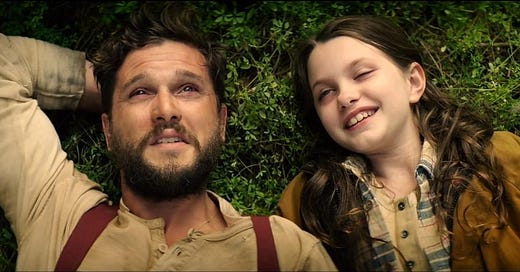The Beast Within
Kit Harington gets hairy but his werewolf movie is hoary, as what passes for atmospheric horror is simply a tired, turgid retread of scareflick tropes.
It’s bad for a movie to be predictable, but even more so for thrillers and horror flicks. Their entire energy is based upon keeping the audience on edge about what will happen next, offering surprises and twists to keep us guessing and engaged.
There wasn’t one damn thing that happened in “The Beast Within” that I didn’t see coming way, way off. It’s a werewolf movie starring “Game of Thrones” star Kit Harington, who as you imagine gets quite hairy. But his movie is a hoary retread of scareflick tropes, aiming for atmospheric horror but instead registering as tired and turgid.
They say canines can smell at least 10,000 times better than humans. But you don’t need any sort of extrasensory powers to sniff out which direction this movie is heading.
It’s set in the deep remote forests of England somewhere unnamed. The story is seen through the eyes of Willow Avery, a girl of about 10 played by Caoilinn Springall. She’s the best thing in the movie, a big-eyed waif whose emotions play out with liquid ease on her face.
A sickly child who often has to use a portable oxygen tank to keep from suffocating respiratory attacks, Willow lives on a tumbledown farm with her mother, father and grandfather. Harington is the dad, Noah, who’s barely seen at all until about a third of the way through the movie. He’s a timber man whose entire occupation seems to be splitting wood, when he’s not recovering from his latest lycanthropic spell.
Around the time of the full moon each month, Noah is taken away by his wife, Imogen (Ashleigh Cummings) and father-in-law, Waylon (James Cosmo), to some mysterious destination deep in the woods. When they fetch him back the next day, he’s moony and incapacitated, staying in bed, writhing and mewling.
Eventually, of course, Willow starts to investigate the family mystery and discovers the truth. Oddly, this actually seems to improve her relationship with her dad for a time, as he no longer has the burden of keeping his darkest secret from his child.
“The real pain, the true pain comes from hiding it,” he says. They go on excursions together and play at being the king and princess of the forest.
But Noah still shows deep reservoirs of rage and resentfulness, capable of utter kindness one moment and snapping into a frightening fit the next. He talks about his ancestors bearing the same curse, how his grandfather was a kind man while his own father a cruel one, and he himself seems to have inherited a measure of both.
Imogen is an even harder nut to crack, deeply devoted to her husband and daughter but understanding the supernatural chasm between them can’t ever be bridged. Noah is both their provider and single biggest threat — toxic masculinity, manifested.
Granddad is old school, prepared to do whatever it takes to protect his daughter and granddaughter. Noah seems to respect his position and and allows the stern oldster to assert has alpha-ness.
Directed by Alexander J. Farrell, who co-wrote the screenplay with Greer Ellison, the film tries to build on a sense of mood and environment, as the characters live a pastoral life that’s virtually timeless, seemingly set in any era were it not for their motorized vehicle. The woodland setting is well featured in the darkly lovely photography by Daniel Katz.
The creature effects, not fully seen until near the very end, are pretty typical werewolf stuff little different from a hundred other such movies. There’s not a lot of visual innovation in the details or backgrounds, either, with Harington’s eyes flashing yellow before and after his transformations, and a big fat red moon hanging in the sky like a beckoning beacon.
This movie bears no relation to the 1982 movie of the same title or the novel by Edward Levy upon which it was based.
If I were to take a guess, there’s an attempted allegory about domestic violence, with the extreme measures the rest of the family take to deal with Noah’s wolfen periods likened to the coping mechanisms and denial employed by a batterer’s victims. Harington makes Noah a figure of fear and loathing, but also capable of charismatic manipulation.
But in the end, “The Beast Within” is a slow-moving picture with little in the way of surprises or true scares.
“Nothing changes,” Noah and Imogen chant constantly to each other — part ritual, part pledge. Problem is, when you’re making something like the 894th werewolf movie in cinematic history, you need some way to stand out from the pack.





